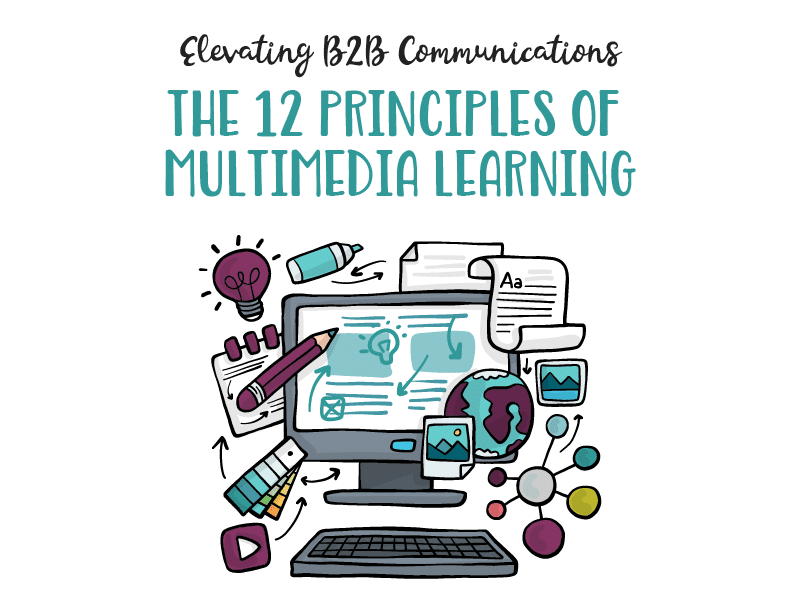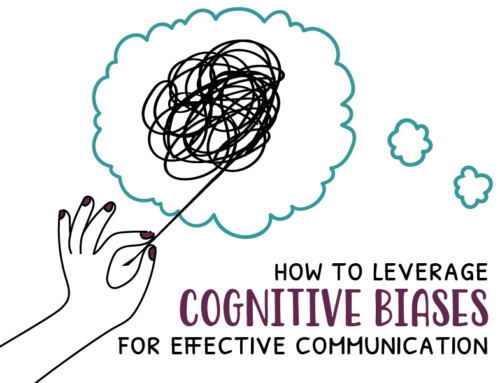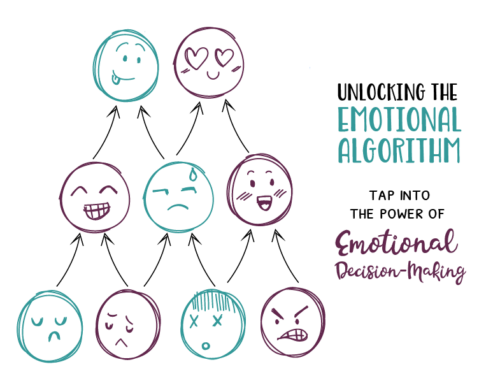In today’s hyper-connected, information-overloaded world, effective communication is more crucial than ever, especially in the business-to-business (B2B) landscape.
While the medium has evolved from print to digital, the core principles that make communication engaging and effective remain. A valuable guide to understanding these principles can be found in Richard E. Mayer’s handbook, “Multimedia Learning.”
Mayer outlines twelve principles that govern the design and organization of multimedia presentations. Interestingly, these principles can be adapted to enhance the effectiveness and engagement level of various B2B communication tools, such as presentations, webinars, interactive demos, or our animated videos.
1
The Coherence Principle of Multimedia Learning
The Coherence Principle advises that people absorb information more effectively when extraneous words, pictures, and sounds are omitted.
The Coherence Principle in Action
In the realm of B2B communications, this principle is a boon for presentations that often become overburdened with excessive details and jargon.
If you’re crafting a B2B sales presentation for a new software solution, focusing on the most vital features and capabilities can substantially elevate audience engagement and retention, while eliminating distracting elements like decorative graphics.
2
The Signaling Principle of Multimedia Learning
The Signaling Principle, which posits that learning is optimized when cues highlight the essential information, can be a game-changer for B2B webinars or video calls.
The Signaling Principle in Action
Using cues like bullet points or highlighted text, you can guide your viewer’s attention toward the crux of the matter.
During a webinar introducing a new project management tool, you might consider flashing keywords or critical questions on the screen at opportune moments, acting as guideposts for the viewer’s attention.
3
The Redundancy Principle of Multimedia Learning
The Redundancy Principle advises that graphics and narration alone are more beneficial for learning than when combined with on-screen text.
The Redundancy Principle in Action
In a B2B video demonstration, this means it’s more effective to employ either narration to clarify the graphics or use on-screen text, but not both.
When presenting a video on installing your software, a clear visual sequence of steps along with guiding narration would suffice. Adding text captions on top of the visuals and narration would be overwhelming for the viewer.
4
The Spatial Contiguity Principle of Multimedia Learning
The Spatial Contiguity Principle emphasizes the importance of positioning related words and pictures close to each other for effective learning.
The Spatial Contiguity Principle in Action
In B2B presentations or infographics, keeping related text and images close enhances information processing.
If you’re explaining the security features of your software in a presentation, for example, placing the icons or pictures representing these features adjacent to the explanatory text can significantly improve comprehension.
5
The Temporal Contiguity Principle of Multimedia Learning
Similarly, the Temporal Contiguity Principle advocates for presenting corresponding words and visuals simultaneously.
The Temporal Contiguity Principle in Action
In a B2B virtual meeting, for instance, it would be prudent to synchronize your narration with the appearance of the corresponding graphics or bullet points on the screen, as this synchronization aids in information retention and understanding.
6
The Segmenting Principle of Multimedia Learning
The Segmenting Principle suggests that multimedia lessons are more effective when broken down into smaller, user-paced segments.
The Segmenting Principle in Action
For example, a lengthy report on market trends could be divided into chapters or sections, allowing your clients to absorb the information at their own pace.
And an animated series might hold viewers’ attention better than a single, overly-long video.
7
The Pre-training Principle of Multimedia Learning
The Pre-training Principle advises that pre-introducing main concepts can enhance the effectiveness of subsequent multimedia lessons.
The Pre-training Principle in Action
Before diving into a complex topic in a B2B webinar, you could send out pre-reading materials or conduct a brief introductory session covering basic concepts.
A short preparatory guide distributed before a webinar on blockchain technology could include definitions and essential terminology, thus equipping the audience for a more in-depth discussion to follow.
8
The Modality Principle of Multimedia Learning
The Modality Principle suggests that narrated words are more effective for learning than on-screen text.
The Modality Principle in Action
Translated to a B2B setting, this means that narrated presentations or videos often outperform text-heavy alternatives.
Instead of a dense, written report, you could provide a narrated video summary that guides the client through the main findings, for instance.

Learn to explain complicated things in a simple way
Find out how to explain complicated things in a simple way that attracts and holds attention, builds trust, engages your audience, and moves them to act.
9
The Multimedia Principle of Multimedia Learning
The Multimedia Principle asserts that a combination of words and pictures improves learning compared to words alone.
The Multimedia Principle in Action
In B2B emails or presentations, incorporating visuals like charts or infographics can result in more impactful communication.
And an email campaign introducing your new product could benefit significantly from the inclusion of infographics alongside the textual explanation.
10
The Personalization Principle of Multimedia Learning
The Personalization Principle advocates for a conversational tone, positing that it’s more effective for multimedia learning than a formal tone.
The Personalization Principle in Action
In B2B tutorials or webinars, adopting a conversational style, as if you’re explaining the topic in a face-to-face meeting, can enhance audience engagement and understanding.
11
The Voice Principle of Multimedia Learning
The Voice Principle promotes the use of human voice-over, arguing that it’s more effective than synthetic voices for learning.
The Voice Principle in Action
For instance, if you’re creating a tutorial for your product, opting for a friendly and relatable human voice for the narration would likely make the material more accessible and engaging.
12
The Image Principle of Multimedia Learning
Finally, the Image Principle advises that the inclusion of the speaker’s image doesn’t necessarily improve learning.
The Image Principle in Action
In B2B settings, this means you shouldn’t feel obligated to include video feeds of speakers during presentations or webinars unless it adds to the content.
For example, a webinar focused on complex data analysis would be better served by dedicating screen space to graphs and charts rather than the speaker’s image.
In summary, Mayer’s twelve principles offer a structured framework for creating effective multimedia presentations.
When adapted to the B2B realm, these principles can greatly improve the quality of various communication tools, ensuring that the message is not only delivered but also retained and understood.
So the next time you’re tasked with creating a presentation, webinar, or any other form of business communication, keep these principles in mind. They might just be the difference between a forgettable presentation and a memorable, impactful one.
And if you need a hand bringing your story to life, please get in touch, and check out some of our whiteboard animation examples.
























Leave A Comment